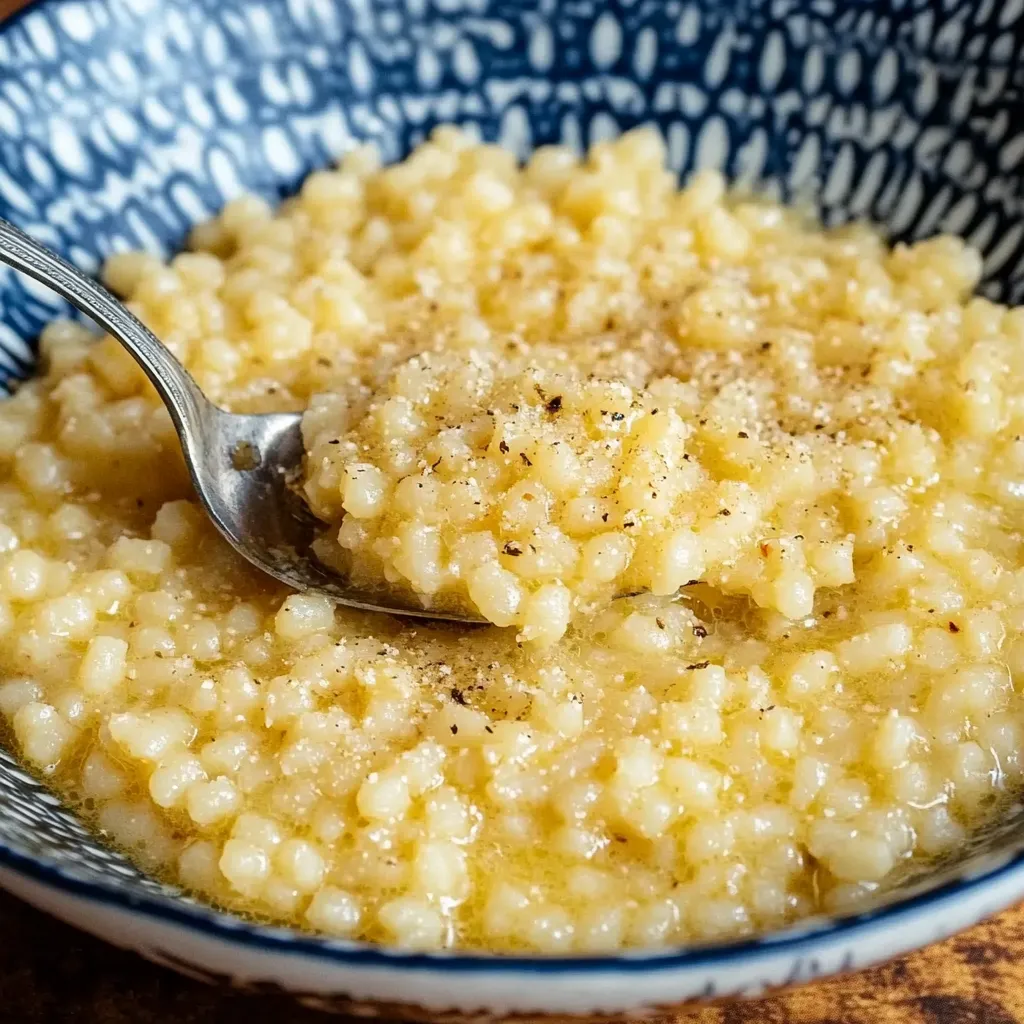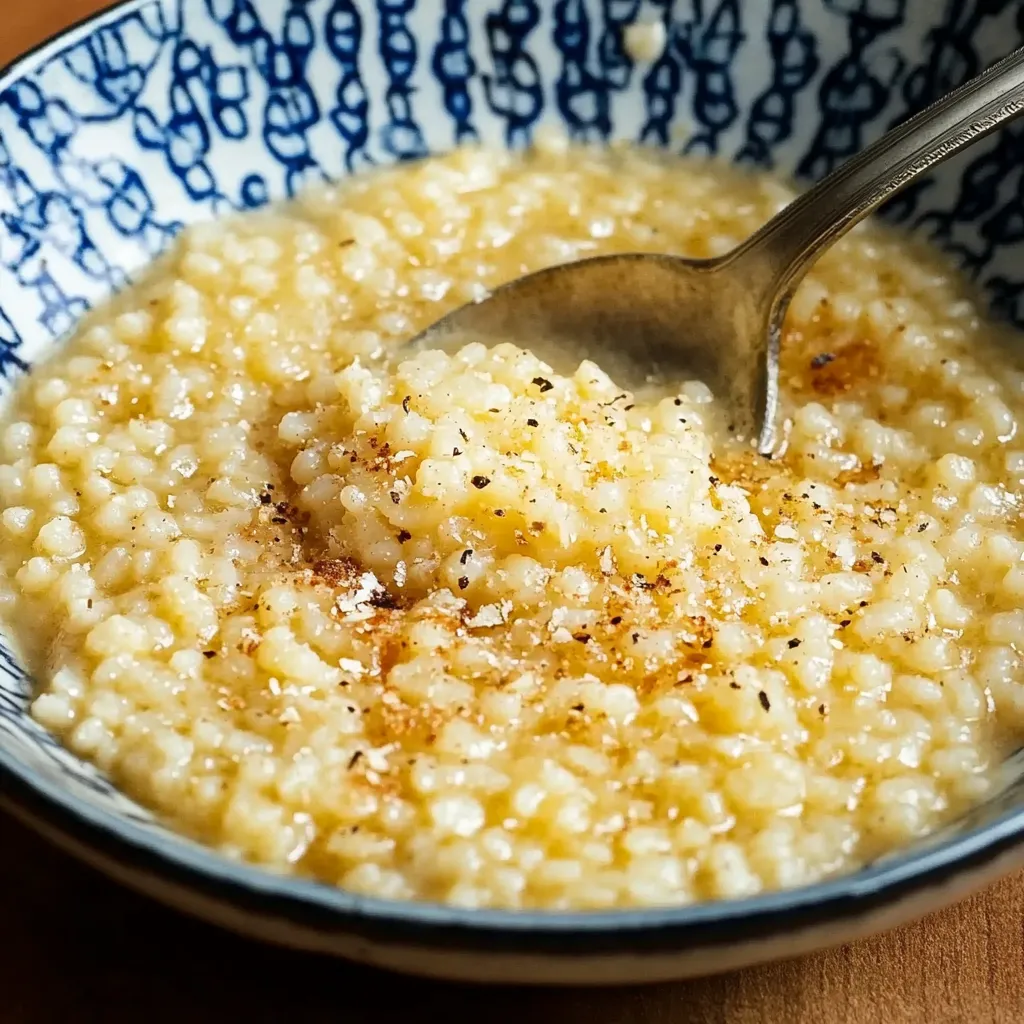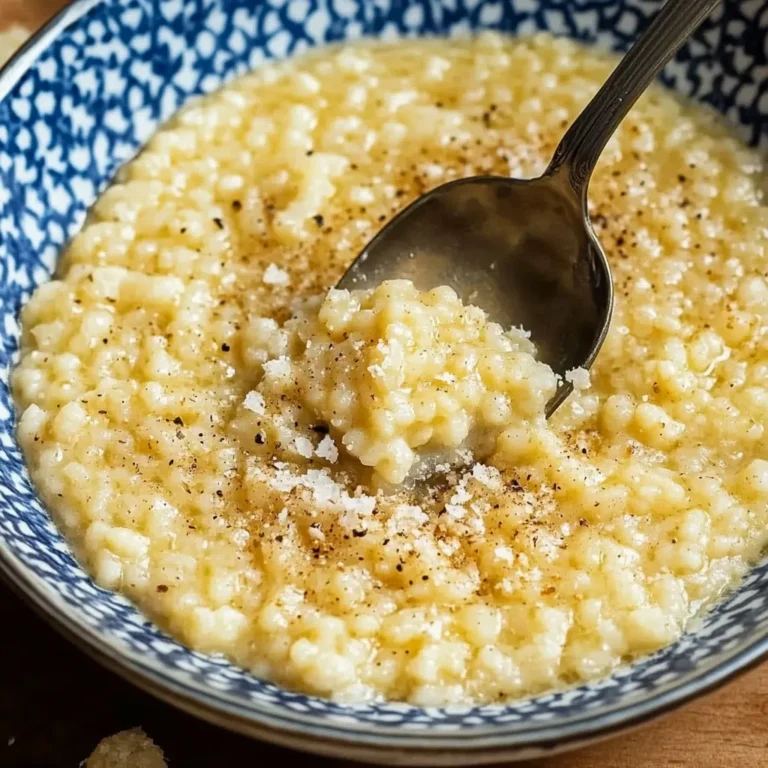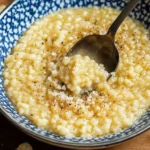Introduction to Pastina
Pastina refers to tiny, star-shaped pasta pieces commonly used in Italian cooking. Unlike typical pasta, pastina is incredibly small, making it ideal for soups, broths, and simple dishes that are easy to digest and quick to prepare. Often viewed as one of the most versatile Italian pasta varieties, pastina is easy to cook and can adapt to countless flavor profiles. Its small size, quick cooking time, and ability to absorb broth and seasonings make it a favorite among Italian families, especially for soothing comfort dishes.
In Italy, pastina holds a unique place in family traditions and memories. Many Italians grew up eating warm bowls of pastina when they were under the weather or needed a comforting meal. Known as the ultimate Italian comfort food, pastina is often called “Italian Penicillin” due to its nourishing and healing properties, especially when cooked in a rich, homemade broth. Adding ingredients like butter, eggs, or Parmesan cheese transforms pastina into a creamy, filling dish that is both simple and satisfying. This comforting quality makes it a staple in Italian households, bridging generations with a recipe passed down from grandparents to children.
Many variations of pastina recipes exist, yet the classic recipe remains simple. For those interested in learning more about Italian food culture, see the History of Italian Cuisine and how it influenced the development of comfort dishes like pastina. Preparing it with chicken broth offers additional health benefits, and the broth itself provides essential nutrients, as detailed in Health Benefits of Chicken Broth.
Ultimately, pastina’s cultural significance as an Italian comfort food is timeless. This humble dish embodies the essence of Italian cuisine, combining minimal ingredients with a depth of flavor, warmth, and tradition.
Brief History of Pastina
The origins of pastina in Italian cuisine trace back centuries, rooted in Italy’s deep-seated love for pasta and comfort food. Pastina, meaning “little pasta” in Italian, evolved as part of the Italian tradition of using small pasta shapes, often reserved for light dishes or to accompany broths. Italians prioritized making meals that were not only delicious but also easy to prepare and gentle on the stomach. The small, delicate shape of pastina made it ideal for this purpose, fitting seamlessly into Italian households as a meal that required few ingredients but brought immense comfort.
In Italian homes, pastina quickly became a staple, especially for children and those recovering from illness. Its mild flavor and smooth texture made it a favorite among parents looking for a dish that was both nourishing and easy to digest. For many Italians, pastina is a meal filled with nostalgia, recalling childhood memories of mothers or grandmothers preparing it when they needed warmth and healing. It is often served in a flavorful homemade broth, which itself is rich in essential nutrients and has additional healing properties, as detailed in How to Make Broth at Home.
This legacy of pastina as an Italian comfort food endures today, with many variations emerging over the years. From the addition of Parmesan cheese to the incorporation of butter or eggs, pastina continues to be a go-to meal that embodies the simplicity and heart of Italian cooking. Its reputation as “Italian Penicillin” highlights its long-standing role in providing both physical and emotional nourishment across generations.
Why Pastina is the Ultimate Comfort Food
Pastina holds a special place in the hearts of many, symbolizing warmth, care, and a sense of home. Known as a classic comfort food in Italy, it is often the first meal Italian children are introduced to and a go-to for parents when their kids are feeling under the weather. The small, delicate pasta combined with ingredients like chicken broth, butter, and Parmesan cheese creates a creamy and flavorful dish that brings a sense of nostalgia and emotional comfort. For many Italians, a bowl of pastina is a reminder of childhood, family gatherings, and the tradition of using simple, nourishing ingredients.
Beyond its emotional appeal, pastina also offers healing properties and nutritional benefits. The combination of broth, which is high in essential vitamins and minerals, and eggs or cheese, provides a boost of protein, aiding in recovery and strengthening the immune system. Chicken broth, especially, has been shown to contain anti-inflammatory properties, as highlighted in Health Benefits of Chicken Broth, making it an ideal choice for those recovering from illness.
Whether for adults needing a comforting meal or children requiring easy-to-digest nourishment, pastina is celebrated as a versatile, nutritious dish. Its simplicity, rich taste, and health benefits continue to make it an essential comfort food, providing warmth and solace across generations.

Ingredients and Preparation of Classic Pastina Recipe
Detailed List of Ingredients
To make a comforting bowl of pastina, you’ll need a few simple, yet flavorful ingredients:
- Pastina: 1 box (12 ounces) – the star of this dish, with its small, delicate pasta shape.
- Chicken broth: 4 cups – adds depth and richness to the dish, making it both hearty and nutritious.
- Butter: 3 tablespoons – for creaminess and a smooth, velvety texture.
- Egg: 1 large, at room temperature and whisked – helps bind the ingredients together, adding protein and a rich, custardy feel.
- Parmesan cheese: ¼ cup, freshly grated – this Italian classic brings a sharp, salty flavor that enhances the dish.
- Black pepper: freshly ground, to taste – adds a subtle kick, balancing the creaminess with a touch of spice.
Using high-quality, fresh ingredients like Parmesan cheese and homemade chicken broth elevates this simple dish, adding layers of flavor and nutrition.
Step-by-Step Instructions for Classic Pastina
Preparation of Ingredients
- Gather Ingredients: Ensure all ingredients are ready. Measure 4 cups of chicken broth, and grate ¼ cup of fresh Parmesan cheese. Crack 1 large egg and whisk it until smooth, setting it aside to reach room temperature. This allows the egg to incorporate seamlessly into the warm pasta for a creamy texture.
Cooking Pastina in Broth
- Cook Pastina: Pour the chicken broth into a medium-sized, 3-quart pot. Bring it to a gentle boil over medium heat.
- Add the Pastina: Once the broth begins to bubble, add the entire 12-ounce box of pastina to the pot. Stir frequently to prevent it from sticking to the pot and to ensure even cooking. Allow it to cook for about 6-7 minutes, or until the pastina is al dente (tender but still slightly firm). The broth should mostly absorb into the pasta, creating a thicker consistency.
Adding Butter, Egg, and Parmesan
- Remove from Heat: Once the pastina reaches the desired texture, remove the pot from the heat.
- Incorporate Creamy Ingredients: Immediately stir in the 3 tablespoons of butter, allowing it to melt and coat the pasta. Next, gradually pour in the whisked egg, stirring continuously to combine. This will add a silky, custard-like creaminess to the dish. Finally, sprinkle in the grated Parmesan cheese, stirring until it’s fully melted and integrated.
Final Seasoning and Serving
- Season with Pepper: Add freshly ground black pepper to taste, balancing the richness with a touch of spice.
- Serve: Dish out immediately for optimal warmth and creaminess. Serve with an extra sprinkle of Parmesan and freshly ground pepper on top for garnish, alongside crusty bread or a simple salad for a comforting Italian meal.
Expert Tips for the Perfect Pastina
Creating the perfect bowl of pastina can be as simple or creative as you like. Here are some expert tips to enhance flavor and customize the dish to your taste.
Suggested Variations
- Substitute the Broth: While chicken broth is traditional, vegetable broth works wonderfully as a lighter, vegetarian option. For a richer taste, consider combining half broth with half milk, adding a creamy texture without needing additional butter.
- Use Homemade Broth: Making your own broth brings incredible flavor and nutrition to the dish. Follow easy steps for making broth with How to Make Broth at Home.
Adjusting Seasoning
- Personalize the Seasoning: Salt and pepper are staples, but you can enhance the depth by adding a pinch of garlic powder, onion powder, or even a hint of nutmeg for warmth. Taste as you go to get the seasoning just right.
Making Pastina More Indulgent
- Add Extra Cheese or Herbs: If you love cheese, try mixing in a few more tablespoons of Parmesan or even a sprinkle of mozzarella for extra richness. Fresh herbs like chopped parsley, basil, or chives can add a burst of color and freshness.
- Make it a Full Meal: For a heartier dish, toss in cooked vegetables such as spinach or carrots, or even shredded chicken for protein.
These adjustments create a versatile and indulgent bowl of pastina, perfect for any taste and occasion.
Nutritional Benefits of Pastina
Pastina may be a comfort food, but it’s also packed with nutritional benefits that make it a wholesome meal option. This dish offers a balanced mix of carbohydrates, proteins, and fats, delivering both energy and essential nutrients.
Nutritional Content Overview
- Carbohydrates: The pastina itself is primarily a carbohydrate source, providing quick energy that’s easy to digest. This makes it ideal for children, those with sensitive stomachs, or anyone recovering from illness.
- Proteins: By adding a whisked egg to the recipe, pastina becomes a more complete meal. Eggs are rich in high-quality protein, essential for muscle repair and immune support.
- Fats: The inclusion of butter contributes healthy fats that help the body absorb fat-soluble vitamins, while Parmesan cheese adds protein and a moderate amount of fat, enhancing both the flavor and the nutritional profile of the dish.
Health Benefits of Key Ingredients
- Chicken Broth: Rich in vitamins, minerals, and collagen, chicken broth supports immune health and aids in digestion. It’s also known to contain anti-inflammatory properties, which can be especially soothing when you’re under the weather. For more on its benefits, see Health Benefits of Chicken Broth.
- Parmesan Cheese: This hard cheese is not only flavorful but also a good source of calcium, promoting bone health. It also contains essential amino acids and a concentrated amount of nutrients compared to other cheeses.
In essence, a bowl of pastina provides comfort along with essential nutrients, making it a nourishing option for both children and adults.

Popular Variations of Pastina Recipes
The beauty of pastina lies in its versatility. While the classic recipe uses chicken broth for flavor, there are many ways to customize this dish to suit different tastes and dietary needs.
Different Types of Broth
- Vegetable Broth: For a vegetarian twist, use vegetable broth instead of chicken. It imparts a light, fresh taste and works well with added herbs and seasonings.
- Beef or Mushroom Broth: To give pastina a deeper, heartier flavor, try beef broth or mushroom broth. These options create a robust, earthy base that adds complexity to the dish, especially when paired with savory ingredients like Parmesan or garlic.
Adding Nutritious Vegetables
- Carrots, Spinach, and More: Boost the nutritional value by adding vegetables such as diced carrots, spinach, or zucchini. These veggies blend seamlessly into the pasta, providing extra fiber, vitamins, and color. Fresh greens like spinach or kale can be stirred in just before serving for a vibrant, nutritious addition.
Creamy Milk-Based Pastina
- Milk-Based Variation: For a creamier, more indulgent version, substitute half of the broth with milk. This adjustment gives pastina a custard-like texture and a mild sweetness, especially comforting in colder weather. Adding milk also enhances the calcium and protein content of the dish.
These variations allow you to adapt pastina to any occasion or preference, making it a versatile comfort food that’s easy to modify while keeping its core comforting qualities intact.
How to Make Pastina Vegan or Gluten-Free
Creating a vegan or gluten-free version of pastina is simple with a few easy substitutions. Here’s how to adapt this classic dish to fit specific dietary needs while preserving its comforting qualities.
Vegan Substitutes
- Replacing Egg and Butter: For a vegan version, skip the egg and replace butter with a plant-based alternative, like vegan butter or a small amount of olive oil for a similar richness. To recreate the creamy texture, try adding a splash of unsweetened almond milk or oat milk towards the end of cooking. Nutritional yeast can also be sprinkled in for a cheesy, savory flavor that resembles Parmesan.
- Broth Choice: Use vegetable broth as the base instead of chicken broth for a fully plant-based dish. This keeps the flavor light and fresh, perfect for a vegan-friendly bowl of comfort.
Gluten-Free Pastina Alternatives
- Gluten-Free Pastina: Look for gluten-free versions of pastina made from rice or corn. These alternatives maintain a similar texture and size, ideal for capturing the essence of traditional pastina. Many stores now carry gluten-free pastina, making it easy to enjoy this dish without gluten.
These adaptations allow anyone with dietary restrictions to savor the warm, nostalgic comfort of pastina.
Serving and Storing Tips
Serving Suggestions and Pairings for Pastina
Pastina is a versatile dish that can be enjoyed as a standalone meal or a comforting side. Its creamy, mild flavor makes it ideal for both casual meals and special occasions, satisfying children and adults alike.
Serving as a Standalone Meal
- Warm and Simple: Serve pastina hot, topped with an extra sprinkle of Parmesan and freshly ground black pepper for added flavor. A drizzle of olive oil or a handful of fresh herbs, such as basil or parsley, can add a burst of color and freshness.
- Additional Protein: For a heartier bowl, add cooked shredded chicken, sautéed mushrooms, or even a poached egg on top, transforming it into a more filling main course.
Pairing Suggestions
- Crusty Bread: A slice of crusty Italian bread is perfect for soaking up any remaining broth and adds a delightful texture contrast.
- Salads: Pair pastina with a light Italian salad featuring mixed greens, tomatoes, and a tangy vinaigrette to balance the dish’s richness.
- Italian-Inspired Sides: Try serving it with bruschetta, marinated olives, or roasted vegetables for a complete Italian-inspired meal.
These pairing ideas allow you to enjoy pastina in various ways, whether it’s as a cozy solo meal or part of a balanced, satisfying spread.
Storage Tips for Leftover Pastina
Storing pastina properly helps retain its creamy texture and flavor for later enjoyment. Here are tips for refrigerating, reheating, and freezing leftovers.
Refrigeration and Reheating
- Refrigerate Leftovers: Place leftover pastina in an airtight container and store it in the refrigerator for up to 3 days. When ready to eat, transfer the pastina to a small pot, add a splash of broth or milk to restore its creamy consistency, and heat on low until warm. Stir occasionally to prevent sticking and ensure even heating.
- Microwave Option: Alternatively, reheat in the microwave, adding a bit of broth or milk, then covering the container loosely. Heat in 30-second intervals, stirring in between until it’s thoroughly warmed.
Freezing and Thawing
- Freezing Tips: For longer storage, freeze pastina in individual portions to make thawing easier. Use a freezer-safe container, leaving some space for expansion. Pastina can be stored in the freezer for up to 2 months.
- Thawing and Reheating: To thaw, transfer the frozen portion to the refrigerator overnight, then reheat as usual. Add a little broth or milk to refresh the creamy texture and flavor.
These storage methods help keep pastina delicious and ready to enjoy at any time.

Frequently Asked Questions (FAQs) About Pastina
Is Pastina Only for Children?
No, pastina is enjoyed by people of all ages! While it’s often given to children for its mild flavor and easy digestion, adults also appreciate pastina’s comforting qualities. Its simplicity and versatility make it a great option for anyone seeking a warm, nostalgic meal.
Can I Use a Different Pasta Shape?
Yes, you can substitute other small pasta shapes if pastina isn’t available. Options like orzo, acini di pepe, or stelline (small stars) offer similar textures and can be cooked the same way. However, the classic tiny shape of pastina is what gives the dish its signature texture and quick cooking time.
How Do I Prevent Pastina from Becoming Mushy?
To keep pastina from becoming mushy, avoid overcooking it. Cook just until al dente (usually 6-7 minutes), as it will continue to soften in the hot broth. Stirring frequently during cooking also helps ensure an even, non-mushy consistency. When reheating, add a splash of broth or milk to refresh its texture.
What Are the Best Broths to Use with Pastina?
Chicken broth is the most traditional and flavorful choice for pastina. For vegetarian versions, vegetable broth works well, providing a lighter taste. Richer broths like beef or mushroom broth can add depth, especially if paired with additional flavors like garlic or herbs.
Can I Make Pastina Without Cheese or Egg?
Yes, pastina can be made without cheese or egg for a lighter version. Simply skip the Parmesan and egg, and instead add a bit of olive oil or vegan butter for richness. This makes a delicious and simpler version that’s still comforting and flavorful.
Conclusion: Embracing Pastina as a Timeless Comfort Dish
Pastina is more than just a simple pasta; it’s a timeless comfort food that embodies warmth, nostalgia, and the versatility of Italian cooking. With its ability to adapt to various ingredients—from broths and vegetables to cheese and herbs—pastina offers something for everyone, whether you’re seeking a light meal or a hearty, creamy dish. Its gentle flavor and easy preparation make it perfect for all ages and occasions.
We encourage you to try this classic recipe at home, customizing it to your taste. With endless possibilities, pastina is sure to become a cherished favorite in your kitchen!
PrintPastina – Italian Comfort Food
A comforting Italian pasta dish with tiny pastina pasta cooked in chicken broth, butter, egg, and Parmesan cheese. Creamy, cozy, and nourishing, perfect for all ages.
- Prep Time: 5 minutes
- Cook Time: 7 minutes
- Total Time: 12 minutes
- Yield: 4 servings 1x
- Category: Main Dish or Side
- Method: Stovetop
- Cuisine: Italian
- Diet: Vegetarian
Ingredients
1 (12- ounce) box pastina
4 cups chicken broth
3 tablespoons butter
1 large egg, room temperature, whisked
1/4 cup freshly grated Parmesan cheese, and more to garnish
Fresh ground black pepper to taste
Instructions
Add 4 cups of broth and the box of pastina into a 3- quart pot over medium heat. Bring to a boil, stirring frequently, and boil for 6-7 minutes, until the broth is absorbed and the pastina is al dente.
Remove the pot from the heat and immediately stir in the butter, egg, and Parmesan cheese.
Season liberally with pepper and serve immediately.
Notes
For extra creaminess, substitute half of the broth with milk. Customize with additional cheese or herbs like basil or parsley.
Nutrition
- Calories: 250 kcal
- Sodium: 780 mg
- Fat: 8 g
- Saturated Fat: 5 g
- Carbohydrates: 32 g
- Protein: 10 g
- Cholesterol: 90 mg


